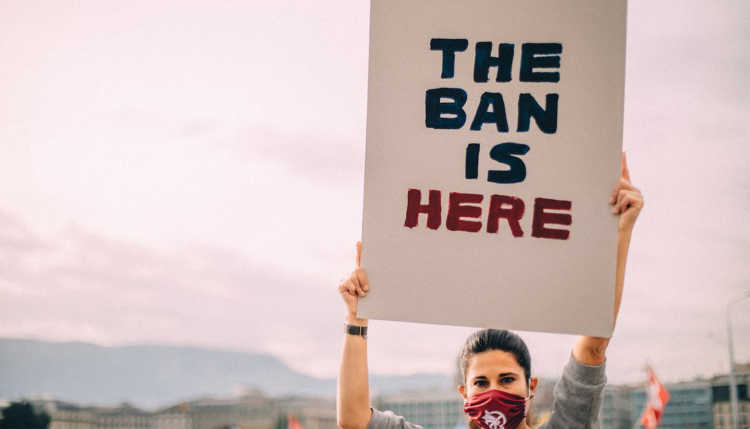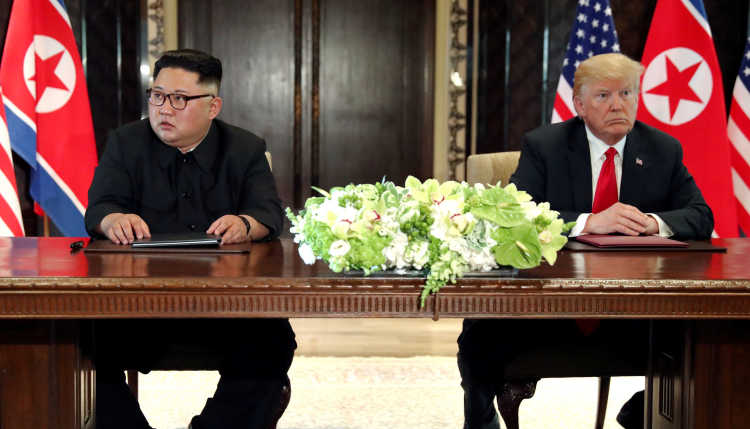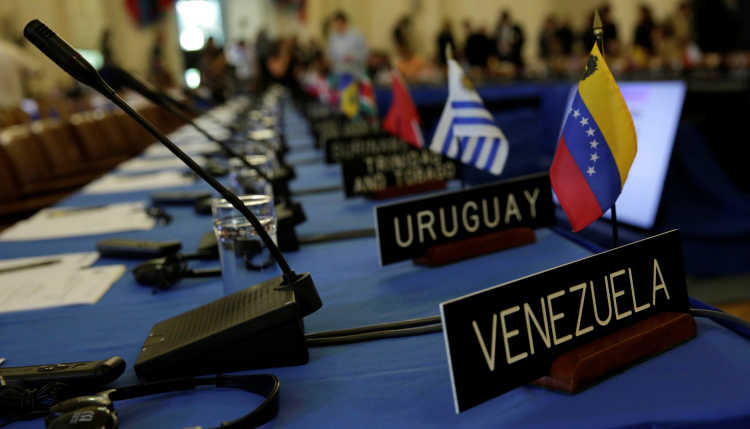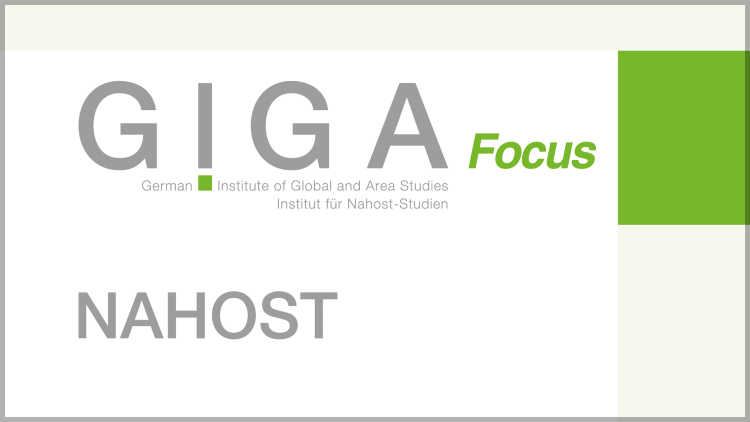- Startseite
- Publikationen
- GIGA Focus
- Fresh Wind Out of the South: What to Expect from a Binding Nuclear Ban Treaty
GIGA Focus Global
Frischer Wind aus dem Süden: Der Atomwaffenverbotsvertrag tritt in Kraft
Nummer 5 | 2020 | ISSN: 1862-3581

Am 75. Jahrestags des Atombombenabwurfs auf Hiroshima und Nagasaki hat ein unbeachtetes Ereignis die internationale Nuklearpolitik erschüttert. Mit seiner 50. Ratifizierung tritt der Atomwaffenverbotsvertrag (TPNW) verbindlich in Kraft. Sowohl die Vor- und Nachteile dieses Vertrages als auch mögliche Konsequenzen, die sich daraus ergeben könnten, und drei mögliche Zukunftsszenarien sind eine Analyse wert.
Bisher waren Atombomben die einzigen Massenvernichtungswaffen (Weapons of Mass Destruction, WMD), die nicht völkerrechtlich verboten sind. Auch wenn die Atommächte über rechtliche Verpflichtungen zur Abrüstung verfügen, kommen sie in diesem Bereich - wenn überhaupt - nur langsam voran. Mit dem Verbotsvertrag sollen diese Rechtslücke geschlossen und die Abrüstungsverhandlungen beschleunigt werden.
Das TPNW ist ein umstrittener Vertrag. Die Kritik reicht von der breiten Auslegung des Textes und dem Mangel an Substanz bei den technischen Verfahren bis hin zu der Frage, wer ihn ausgehandelt hat. Da dieser Vertrag von den Atommächten boykottiert wird, weisen die Kritiker darauf hin, dass er keinerlei praktische – oder allenfalls negative Wirkung haben wird.
Die meisten Kritiken übersehen allerdings die normativen Grundlagen des Verbotsvertrages sowie sein Hauptziel, das darin besteht, langfristig ein ideelles und soziales Umfeld zu schaffen, das einen Frieden ohne Atomwaffen ermöglicht. Der Vertrag sollte als ein weiteres Instrument betrachtet werden, um Druck auf das Ziel in Richtung nuklearer Abrüstung auszuüben und die Nichtverbreitung von Atomwaffen sicherzustellen.
Fazit
Das Inkrafttreten des Verbotsvertrages ist an sich schon ein relevantes Ereignis mit Konsequenzen für die laufenden Abrüstungsgespräche. Die Atomwaffenarsenale werden zwar nicht sofort abgebaut; jedoch kann langfristig ein erhöhter öffentlicher und gesellschaftlicher Druck zu einer wirksamen Stigmatisierung von Atomwaffen führen, wodurch eine atomwaffenfreie Welt möglich werden könnte. Deutschland ist dem Vertrag nicht beigetreten, kann jedoch aufgrund einer aktiven Zivilgesellschaft und der Mitgliedschaft im Atlantischen Bündnis zu einer Brücke zwischen Mitgliedern und Boykotteuren des Vertrags werden.
The Rise of Nuclear Prohibitionism
October 2020 was an exciting month for those interested in the non-proliferation of nuclear weapons. On the 22nd, the United States sent a letter to all signatories of the Treaty on the Prohibition of Nuclear Weapons (TPNW), also known as the nuclear (weapon) ban treaty (Ban Treaty), urging them to withdraw from it (APNews 2020). Only one day later, however, Jamaica and Nauru both ratified the nuclear ban, followed by Honduras on the 24th (which marked United Nations Day). With 50 ratifications, the TPNW is now set to become binding within 90 days hence, and the first meeting of state parties should be convened within the next 12 months.
Seventy-five years after the bombing of Hiroshima and Nagasaki, the Ban Treaty brings a new legal norm that prohibits developing, testing, producing, manufacturing, possessing, or stockpiling all kinds of nuclear explosive devices (Article 1, a). It is also a polemical and polarising treaty, with critics and supporters found all over the world. What the TPNW is, the countries that support it (and those that do not), and what to expect now that it will become binding are all examined. The Ban Treaty, it is argued, is a relevant legal and normative instrument, even if not having immediate practical effects.
Eliminating nuclear weapons is an old ambition of international society, expressed in the very first resolution of the United Nations General Assembly (UNGA) from 1946. Since then, countries have developed a plethora of intertwined institutions and organisations – a regime – aiming to get rid of atomic weapons. This regime is centred on the Treaty on the Non-Proliferation of Nuclear Weapons (NPT), opened to signatures in 1967 and binding since 1970. The NPT is grounded in three pillars: non-proliferation (i.e. avoiding new countries going nuclear); nuclear disarmament; and, peaceful uses of atomic energy. Those pillars are also called “the grand bargain”: non-nuclear-weapon states agreed to close the atomic door, as long as nuclear-weapon states eliminated all of their own arsenals “in good faith” (Article VI of the NPT). Fifty years later, however, not a single bomb has ever been dismantled by the force of compulsion of a multilateral treaty. Nuclear disarmament remains a thorny issue, and, until now, nuclear arms were the only kind of weapon of mass destruction yet to be banned globally.
The bargain was not yet met. The Ban Treaty is, in that regard, first and foremost a reaction by non-nuclear-weapon states to the lack of progress in nuclear-disarmament negotiations. They have run out of patience. Discussions on how to fulfil obligations under Article VI of the NPT regularly reach an impasse in all Review Conferences. Countries with nuclear weapons and most of their allies advocate for a “step-by-step approach” to disarmament. According to this, irreversible, enforceable, and verifiable disarmament can only be achieved after establishing a safe international security environment and standing institutions that prevent duplicity. This is a long-term goal.
In the year 2000 the NPT Review Conference approved the 13 practical steps to nuclear disarmament, following a draft proposal by the New Agenda Coalition – a group of geographically dispersed middle powers that do not belong to any nuclear alliance. The 2010 NPT Review Conference drafted a road map on how to achieve verifiable disarmament, but nuclear powers rejected the proposed timeline. The Review Conference also adopted the UN Secretary-General’s five-point proposal for nuclear disarmament, which included the call for negotiating a “Nuclear Weapons Convention,” similar to those tackling chemical and biological arms. Five years later, the 2015 NPT Review Conference was marked by the impasse reached. In the meantime, tensions between nuclear powers have risen, particularly after the 2014 Russian annexation of Crimea, the growing stand-off in the South China Sea, and the 2016 election of Donald Trump – which was followed by the United States’ subsequent withdraw from the nuclear deal with Iran and from the Intermediate-Range Nuclear Forces Treaty (INF) too.
In parallel to all of that, a different perspective on nuclear weapons has been cemented in many non-nuclear-weapon states: the prohibitionist approach. Prohibitionists propose to shift the focus from security-related issues to the societal and humanitarian impacts of atomic weapons. One of their main arguments is that institutions that create norms against the possession of nuclear weapons can, and indeed should, precede the de facto elimination of atomic arsenals. Most proponents even argue that those norms can create ideational conditions that enable full disarmament. Norms – especially legal rules – could, therefore, speed up and ensure progress on nuclear disarmament.
A critical turning point that enabled the consolidation of the prohibitionist approach was the creation of the International Campaign for the Abolition of Nuclear Weapons (ICAN) in 2007. ICAN is a coalition of over 500 non-governmental organisations across more than 100 countries. Inspired by the success of the International Campaign to Ban Landmines (ICBL), ICAN campaigns for the complete elimination of nuclear weapons worldwide. It also coordinates civil society initiatives towards that goal. It was active in three major conferences on the humanitarian impacts of nuclear explosions: in March 2013, in Oslo (Norway); in February 2014, in Nayarit (Mexico); and in December 2014, in Vienna (Austria). In 2017, it was awarded the Nobel Peace Prize.
Those conferences led to the “Humanitarian Pledge,” calling for the “urgent and full implementation of existing [disarmament] obligations.” The Pledge urged countries to “stigmatise, prohibit, and eliminate” nuclear weapons. Some 127 countries signed it. In 2016, the UNGA adopted Resolution 71/258, convening a negotiating conference to draft a binding instrument to ban atomic weapons. Negotiations took place in New York in September 2017 with the participation of 124 countries, but it was boycotted by all nuclear-weapon states and their allies – with the exception of the Netherlands. Of the participating countries, 122 voted in favour of the final text, while one voted against (the Netherlands) and one abstained (Singapore). The final text of the Ban Treaty was opened to signatures on 7 July 2017. It is set to become binding 90 days hence from 24 October 2020, when, as noted, Honduras became its 50th ratifier.
What is the Ban Treaty, and Who is There?
The Ban Treaty is a broad instrument that creates a legal norm prohibiting the possession of nuclear weapons. At its core it is a stigmatisation instrument, aimed at creating an ideational and societal environment compatible with a non-nuclear-weapons peace. Behind it is the understanding that post–Second World War international stability has been sustained not by the balance of terror but by the establishment of effective multilateral international institutions and the rule of law – as highlighted by Costa Rican ambassador Elayne Gomez-White, who chaired the negotiating conference (UN 2017, 0‘35‘‘ -5‘40‘‘). The aim is, therefore, to push for a long-term environment in which nuclear weapons are rejected as barbarian instruments of the past.
The TPNW is also a polemical treaty. Supporters argue that it is the first step towards a nuclear-free world. It is a broad treaty, but, nonetheless, a relevant one – “idealistic, but still relevant”. It was, furthermore, the result of an inclusive negotiating process, which included civil society – through ICAN –, small states, and populations directly affected by nuclear explosions. Besides prohibiting nuclear explosive devices (Article 1), it also addresses gender issues (in the preamble), nuclear-weapon-free zones (also in the preamble), the environmental impacts of nuclear explosions and remedies for that (Article 6), assistance to victims of nuclear tests (Article 7), and it bans deterrence theory (preamble).
Critics argue that the scope of its text is far too vague. Article 4 (“Towards the Total Elimination of Nuclear Weapons”) does not define the appropriate organisation to verify and oversee the disarmament procedure – it mentions instead only a “competent international authority.” It also does not address timelines to disarmament, nor many of the 13 steps to nuclear disarmament already agreed in the NPT Review Conferences. Full adhesion to the Comprehensive Nuclear-Test-Ban Treaty (CTBT) is, for instance, addressed merely in the preamble and there is no mention of negotiations towards a fissile material cut-off treaty – one of the most relevant phases of the step-by-step approach.
Participating countries
Most critiques focus, however, on who is in that treaty and on how it is relates to existing institutions (especially the NPT). The first stream of argumentation argues that the TPNW is either irrelevant or dangerous. It is considered irrelevant because it is composed of small and economically unimportant states that, in any case, are already nuclear-free (Alvim et al. 2017). The comparison between Figures 1 and 2 below illustrates that argument. Figure 1 shows the positions of all countries vis-à-vis the NPT (as of 25 October 2020). The universe of cases is 197 countries, as available in the ICAN ratifications monitor (ICAN 2020). Ratifiers (dark blue) are those countries that ratified the Ban Treaty. Signatories (light blue) are those who have signed but not yet ratified it. Boycotters (in red) are those that are officially against the treaty, and who voted against covening the negotiating conference too. Supporters (in cream) are those that voted in favour of convening the negotiating conference and/or those that participated in it. Abstainers (in orange) are those abstained from voting in the resolution establishing the negotiating conference.
Figure 1 shows that most supporters, signatories, and ratifiers of the Ban Treaty are countries indeed already covered by nuclear-weapon-free zones. Nuclear-weapon states and countries under atomic umbrellas partake in a boycott movement. This coincidence was, however, to be expected, as the genesis of the Ban Treaty is exactly the lack of progress in disarmament efforts. Having only nuclear-free states is also a positive development, as those countries until now had no permanent forum to assemble in so as to coordinate common positions.


Most supporters of the Ban Treaty are, furthermore, countries concentrated in the Global South – with the noteworthy exceptions of Austria, Ireland, and New Zealand. These are countries usually overlooked in non-proliferation and disarmament policy, but which are gaining a new relevancy in defining nuclear politics. The whole of African and Latin American countries support, for instance, the Ban Treaty, as do most of those in Asia-Pacific and the Middle East. Most small island states – some of which, like the Maldives, were harmed by nuclear testing – are not only part of the treaty but were also among the first ratifiers. This explains why ratifiers are not among the world’s countries with the largest gross domestic products.
Table 1 and Figure 3 below show some descriptive data on the basis of the universe of 197 countries, and some economic data from the World Bank. It is evident herefrom that although supporters, ratifiers, and signatories make up of a large majority of countries worldwide (about 75 per cent), they also, as critics argue, are mostly small states or small economies. Relevant to highlight, however, is the fact that these figures do not reveal the support for the Ban Treaty inside boycotter countries themselves. ICAN itself, for instance, was founded in Australia, a boycotter of the Ban Treaty. In Germany, as another example, a 2019 YouGov poll shows that 71 per cent of people think that their country should join the Ban Treaty (ICAN 2019) – even though another poll also shows that (in the meantime) only 31 per cent of Germans support forgoing all kinds of nuclear umbrella (Körber Stiftung 2019).

The data in table 1 above addresses two main critiques levied against the countries involved in drafting and signing the Ban Treaty: (1) that only small countries are involved, and they do not include the most relevant actors (the nuclear powers); (2) that only democracies would be affected by it. I tackle these two criticisms by evaluating four empirical indicators: population and GDP (both with data from the World Bank), military strength (with data from the the Global Fire Power Index), and democracy levels (with data from the Freedom House). Data was acquired for all 197 states, except regarding the FirePower Index – whose data for most small countries is not available. All values were calibrated to be comparable, being situated on a continuum ranging from 0 (which assigns the minimum lower value for each indicator) and 1 (which assigns the maximum value).
The countries participating in the Ban Treaty are indeed smaller economies in term of GDP. It is, however, not verifiable that they have smaller populations. The graphs comparing categories on the basis of population data from the World Bank shows that the universe of boycotters is skewed, due to the presence of countries like China, India, and the US – with large economies and populations alike. The same observation is true for military power – even though in that case the data is, as noted, incomplete.
The second criticism is that a nuclear ban is dangerous because it will only be effective against the “good” democratic states, while “bad” autocracies will not feel pressured to disarm. This argument was first stated by US ambassador to the UN Nikki Haley in a press conference held in July 2017 (UN 2017a; Halley 2017). Data from Freedom House shows, however, that even though boycotters are indeed mostly democratic coutries – and therefore more susceptible to domestic public opinion pressures – ratifiers and signatores are not. The diversity of the countries participating (ratifiers, signatories, and supporters) indicates that the democratic argument should be, at least, reframed.




Relations with the NPT
Another stream of criticism, in fact, focuses on the relations between the Ban Treaty and the NPT. Critics argue that the former will weaken the latter, as it will dilute efforts across multiple arenas of negotiation. Bringing everyone to the NPT was already a long and exhausting process. It started seeing some success only in the 1990s, after the end of the Cold War and, more importantly, the 1995 indefinite extension of the NPT – when disarmament pledges were renewed. Today, only five countries are on the outside of the NPT: India, Israel, North Korea (withdrawn), Pakistan, and South Sudan. From those, only South Sudan is not considered a pariah on non-proliferation issues. Critics argue, therefore, that creating a new “competing” institution would harm the NPT, with new efforts being discussed outside its Review Conferences. Those endeavours would, furthermore, be innocuous, as armed states would not be involved. A universal – albeit imperfect – institution (the NPT) hence risks being substituted by an ineffective and restricted forum. If anything, nuclear-weapon states would try to oppose it by resuming development of such arms.
This argument has two main problems to it. First, it ignores that multiple institutions already shape the nuclear non-proliferation regime, and they are universally seen as complementary rather than competing. They reinforce rather than weaken one another. A similar argument was, indeed, employed in the 1960s to criticise the creation of nuclear-weapon-free zones. Before the 1962 Cuban Missile Crisis, Latin American states – pressured by the US – rejected the concept of nuclear-weapon-free zones, arguing that regional-centred treaties would not only be ineffective but they would also divert attention away from global non-proliferation and disarmament negotiations held in Geneva and New York (Wrobel 2017). Today, however, these regional treaties are vital to ensure the stability of regional non-nuclear environments. A similar trend is expected with the Ban Treaty. The preamble thereof reaffirms, indeed, the NPT as “the cornerstone of the nuclear disarmament and non-proliferation regime.”
And Now, What? Three Possible Scenarios
Despite all the above-mentioned critiques, the Ban Treaty is out there. And it is soon to be legally binding. The TPNW has already shown its relevance merely by existing – being the first multilateral nuclear arms control and disarmament treaty fully negotiated since the CTBT, which despite being opened to signatures in 1996 is still not binding. It represents the ultimate achievement of a global civil society movement against nuclear weapons and a self-evident manifestation of an ever-more multipolar international order. Three possible scenarios going forwards are worthy of consideration in closing: success, failure, irrelevance.
The first scenario is that of success. It follows as such: in the medium run, the Ban Treaty becomes a forum where non-nuclear-weapon states discuss common positions and find consensual approaches to pressure for disarmament. The Ban Treaty conferences become a socialising forum, in many ways similar to what already happens in nuclear-weapon-free zones like Latin America. Small states join forces, and increase their leveraging power in disarmament negotiations. The treaty eventually attracts some members of nuclear alliances, like the North Atlantic Treaty Organization, even if only as observers. For that, civil society mobilisation was central. More cohesion among the non-nuclear-weapon majority oversees a revival of the negotiations within the NPT Review Conferences. Nuclear-weapon states and their allies react by making progress on the basis of a step-by-step approach. In the long run, it leads the whole of international society to stigmatise atomic weapons – to the point that keeping hold of costly and anachronic nuclear arsenals becomes politically unbearable. Just like had happened previously with overt chemical and biological arsenals. Leaders finally negotiate a fissile material cut-off treaty. The CTBT also comes into force. Soon after, countries dismantle their atomic arsenals voluntarily, and they sign comprehensive nuclear safeguard agreements with the International Atomic Energy Agency. Dissenters are further reproached as pariahs or even outlaws.
The second scenario is that of failure. It follows as such: realpolitik and deterrence logics impose themselves, as competition and disagreements between nuclear-weapon states increase. Gradually, larger state parties – like Brazil, Indonesia, Malaysia, or Nigeria – lose interest in the Ban Treaty. Some of them did not even ratify it in the first place. Other countries may even withdraw from the TPNW, pressured into doing so by nuclear-weapon states. Idealistic small states have their call unheard, and are left alone. The divide between nuclear-weapon haves and have-nots becomes a chasm. The Ban Treaty’s limited effect is restricted to small democracies alone, some of them left unprotected by nuclear umbrellas. Further proliferation is even likely to occur, as contestation of the step-by-step approach leads to a loss of credibility. The Ban Treaty becomes one more forgotten historical experiment – just like the 1976 Threshold Test Ban Treaty, which was set to lay the grounds for “peaceful nuclear explosions.”
The last scenario is that of irrelevance. It is grounded in the assumption that all of the pros and cons arguments overstate the real value of the Ban Treaty. In the end, it was, in fact, so general and so broad that it failed to have any impact at all. The impasse within the NPT Review Conferences continues, and the slow progress on the step-by-step approach remains. In fact, it may even slow down further. It is business as usual. Maybe in the long run, once progress on nuclear disarmament negotiations has resumed, countries convene again – this time with the participation of the remaining nuclear powers, so as to discuss a more detailed and specific Nuclear Weapons Convention. This is, nonetheless, more likely to occur only if new technologies render atomic arsenals obsolete. In that case, we will all have a new problem besides.
In 2017, negotiators believed that the “success scenario” was feasible and even expected in the long run. When staring at the past, they attempt to mirror prior achievements — such as outlawing chemical weapons. In this regard, the path that led to the 1992 Chemical Weapons Convention was paved by the work of and the normative statements produced by the 1968 18-Nation Disarmament Committee. Regarding chemical weapons, 24 years were thus needed in order to see some practical results (which is much less than the 50 years and counting required since the signature of the NPT). It is, however, grounded in the premise that the moral and normative value of the treaty would superimpose the comparatively lower material capabilities of its member states. As shown, however, these states are not as weak as they seem, particularly when looking at the number involved and when considering the role of civil society organisations like ICAN. The “success” scenario remains, therefore, a very likely one in the long run.
The “failure” and the “irrelevance” scenarios are in line with the worst predictions by opponents of the Ban Treaty. They are grounded in concerns regarding the nature of the participating countries in the Ban Treaty and relations with existing institutions, mainly the NPT. These scenarios focus on realpolitik and overlook the very elements that enabled the draft of the TPNW in the first place, like the successful “hallway” diplomacy pursued by civil society. This cilivian rooting, as well as the moral principle sustaining the concept of a nuclear ban, should render the “failure” scenario unlikely. The irrelevance one, however, is still a possibility, particularly when considering the fast-paced advances in dual-use technologies like artificial intelligence and automated machines.
What will likely occur is something in between success and irrelevance, depending, first and foremost, on the actions of the countries outside of the TPNW. The nuclear ban will probably not lead to the immediate dismantling of atomic arsenals. In the long run, however, it will most likely become a powerful normative instrument – even if substituted in future by a more precise Nuclear Weapon Convention. This normative force derives from the growing repudiation of nuclear weapons. This repulsion has gained ground both among civil society and the vast majority of countries worldwide. The extent to which the Ban Treaty will impact other countries and institutions, particularly the NPT Review Conferences, is yet to be seen. Prospects are, however, so far positive.
Fußnoten
Literatur
Alvim, Carlos Feu, Olga Y. Mafra, Leonardo Paredes, and Leonam Guimarães (2017), O Tratado de Proibição de Armas Nucleares e a Posição do Brasil na Área Nuclear, in: Economia e Energia (blog), 28 November, http://ecen.com.br/?page_id=904.
APNews (2020), US Urges Countries to Withdraw from UN Nuke Ban Treaty, 21 October 2020, https://apnews.com/article/nuclear-weapons-disarmament-latin-america-united-nations-gun-politics-4f109626a1cdd6db10560550aa1bb491.
Freedom House (2020), Freedom Scores, https://freedomhouse.org/countries/freedom-world/scores (25 October 2020).
ICAN (2020), Signature and Ratification Status, www.icanw.org/signature_and_ratification_status (25 October 2020).
ICAN (2019), Polls: Public Opinion in EU Host States Firmly Opposes Nuclear Weapons, www.icanw.org/polls_public_opinion_in_eu_host_states_firmly_opposes_nuclear_weapons (25 October 2020).
Körber Stiftung (2019), The Berlin Pulse: German Foreign Policy in Perspective, www.koerber-stiftung.de/fileadmin/user_upload/koerber-stiftung/redaktion/the-berlin-pulse/pdf/2019/TheBerlinPulse_2019_FINAL.pdf.
NTI (2020). New Agenda Coalition, www.nti.org/learn/treaties-and-regimes/new-agenda-coalition/ (23 October 2020).
UN (United Nations), Treaty on the prohibition of nuclear weapons, www.un.org/disarmament/wmd/nuclear/tpnw/ (28 October 2020).
UN (United Nations) (2017a), A Total Ban on Nuclear Weapons? – Media Stakeout with Nikki Haley and Others, www.youtube.com/watch?v=FnjcbgH4Gu4.
UN (United Nations) (2017b), Elayne Whyte Gómez on the Treaty on Prohibition of Nuclear Weapons – Press Conference (7 July 2017), New York, https://www.youtube.com/watch?v=lwTEx1jixSE&t=353s.
UNGA Resolution 1(I) is available online at: https://undocs.org/en/A/RES/1(I) (23 October 2020).
UNODA (ND), Nuclear-Weapon-Free Zones, www.un.org/disarmament/wmd/nuclear/nwfz/ (25 October 2020).
World Bank (2019), World Bank Open Data, https://data.worldbank.org/ (23 October 2020).
Wrobel, Paulo (2017), Brazil, The Non-Proliferation Treaty and Latin America as a Nuclear Weapon-Free Zone, 2nd ed., Brasília, DF: Funag.
Gesamtredaktion GIGA Focus
Redaktion GIGA Focus Global
Lektorat GIGA Focus Global
Regionalinstitute
Forschungsschwerpunkte
Wie man diesen Artikel zitiert
Bandarra, Leonardo (2020), Frischer Wind aus dem Süden: Der Atomwaffenverbotsvertrag tritt in Kraft, GIGA Focus Global, 5, Hamburg: German Institute for Global and Area Studies (GIGA), https://nbn-resolving.org/urn:nbn:de:0168-ssoar-70399-7
Impressum
Der GIGA Focus ist eine Open-Access-Publikation. Sie kann kostenfrei im Internet gelesen und heruntergeladen werden unter www.giga-hamburg.de/de/publikationen/giga-focus und darf gemäß den Bedingungen der Creative-Commons-Lizenz Attribution-No Derivative Works 3.0 frei vervielfältigt, verbreitet und öffentlich zugänglich gemacht werden. Dies umfasst insbesondere: korrekte Angabe der Erstveröffentlichung als GIGA Focus, keine Bearbeitung oder Kürzung.
Das German Institute for Global and Area Studies (GIGA) – Leibniz-Institut für Globale und Regionale Studien in Hamburg gibt Focus-Reihen zu Afrika, Asien, Lateinamerika, Nahost und zu globalen Fragen heraus. Der GIGA Focus wird vom GIGA redaktionell gestaltet. Die vertretenen Auffassungen stellen die der Autorinnen und Autoren und nicht unbedingt die des Instituts dar. Die Verfassenden sind für den Inhalt ihrer Beiträge verantwortlich. Irrtümer und Auslassungen bleiben vorbehalten. Das GIGA und die Autorinnen und Autoren haften nicht für Richtigkeit und Vollständigkeit oder für Konsequenzen, die sich aus der Nutzung der bereitgestellten Informationen ergeben.
















